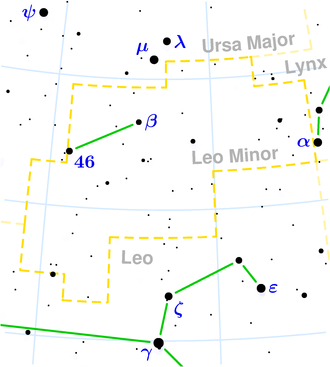NGC 3021
| Galaxy NGC 3021 |
|
|---|---|

|
|
| Image taken with the Hubble Space Telescope | |
| AladinLite | |
| Constellation | Little lion |
|
Position equinox : J2000.0 , epoch : J2000.0 |
|
| Right ascension | 09 h 50 m 57.1 s |
| declination | + 33 ° 33 ′ 13 ″ |
| Appearance | |
| Morphological type | SA (rs) bc: |
| Brightness (visual) | 12.2 mag |
| Brightness (B-band) | 13.0 likes |
| Angular expansion | 1.5 ′ × 0.9 ′ |
| Position angle | 110 ° |
| Surface brightness | 12.4 mag / arcmin² |
| Physical data | |
| Redshift | 0.005140 ± 0.000013 |
| Radial velocity | 1541 ± 4 km / s |
|
Stroke distance v rad / H 0 |
(68 ± 5) x 10 6 ly (20.7 ± 1.4) Mpc |
| history | |
| discovery | William Herschel |
| Discovery date | December 7, 1785 |
| Catalog names | |
| NGC 3021 • UGC 5280 • PGC 28357 • CGCG 182-25 • MCG + 06-22-019 • IRAS 09479 + 3347 • KUG 0947 + 337 • 2MASX J09505711 + 3333124 • GC 1944 • H I 115 • h 645 • LDCE 676 NED004 • KTG 26B | |
NGC 3021 is a spiral galaxy of Hubble type Sbc in the constellation Leo Minor at the northern sky . It is an estimated 68 million light years from the Milky Way and about 30,000 light years in diameter. Together with NGC 3003 and NGC 3067 , the isolated galaxy trio KTG 26 is formed .
In the same area of the sky are u. a. the galaxies NGC 3013 and IC 2508 .
The Type Ia supernova SN 1995al was observed here.
The object was discovered by William Herschel on December 7, 1785 .
